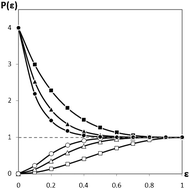Abstract
The molecular structure of any system may be unambiguously described by its adjacency matrix, A, in which bonds are assigned entry aij = 1 and non-bonded pairs of atoms entry aij = 0. For π-electron-containing conjugated

* Corresponding authors
a Institute of Biochemistry and Biophysics, Polish Academy of Science, Pawińskiego 5a, 02-106 Warsaw, Poland
b
Department of Chemistry, Warsaw University, Pasteura 1, 02-093 Warsaw, Poland
E-mail:
arcad@ibb.waw.pl, chamis@chem.uw.edu.pl
c Texas A&M University at Galveston 5007 Avenue U, Galveston, USA
The molecular structure of any system may be unambiguously described by its adjacency matrix, A, in which bonds are assigned entry aij = 1 and non-bonded pairs of atoms entry aij = 0. For π-electron-containing conjugated

 Please wait while we load your content...
Something went wrong. Try again?
Please wait while we load your content...
Something went wrong. Try again?
A. Ciesielski, T. M. Krygowski, M. K. Cyrański and A. T. Balaban, Phys. Chem. Chem. Phys., 2011, 13, 3737 DOI: 10.1039/C0CP01446J
To request permission to reproduce material from this article, please go to the Copyright Clearance Center request page.
If you are an author contributing to an RSC publication, you do not need to request permission provided correct acknowledgement is given.
If you are the author of this article, you do not need to request permission to reproduce figures and diagrams provided correct acknowledgement is given. If you want to reproduce the whole article in a third-party publication (excluding your thesis/dissertation for which permission is not required) please go to the Copyright Clearance Center request page.
Read more about how to correctly acknowledge RSC content.
 Fetching data from CrossRef.
Fetching data from CrossRef.
This may take some time to load.
Loading related content
